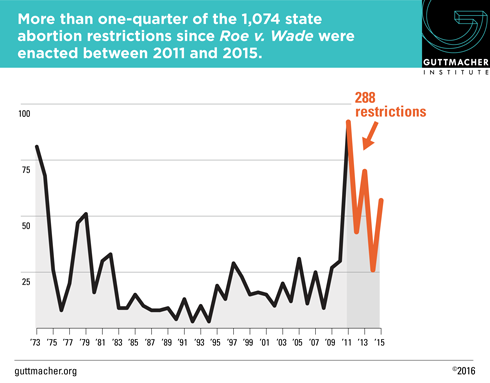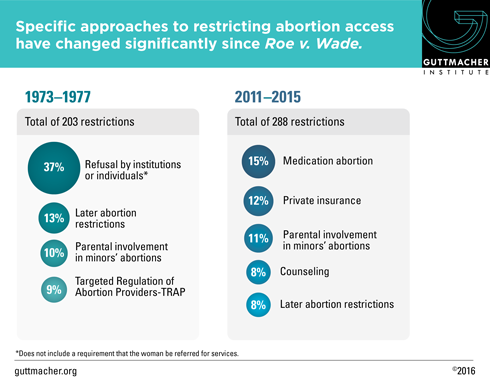In the 43 years since the U.S. Supreme Court handed down Roe v. Wade, states have enacted 1,074 abortion restrictions. Of these, 288 (27%) have been enacted just since 2010. This gives the last five years the dubious distinction of accounting for more abortion restrictions than any other single five-year period since Roe.
During the tumultuous years after Roe voided nearly all state abortion laws, states moved quickly to begin restricting access to the procedure. In the first five years, states adopted 203 restrictions. These measures focused largely on restricting abortions later in pregnancy, establishing onerous requirements for abortion clinics, mandating parental involvement for minors and allowing some institutional and individual providers to refuse to participate without requiring them to refer women for the services they need. Later in that first decade, many states moved to limit public funding for low-income women seeking an abortion. In the decade that followed Roe (1973–1982), states adopted 380 new abortion restrictions, or an average of 38 per year.
Over the next 28 years (1983–2010), states adopted 406 restrictions. States added an average of 14 restrictions per year, ranging from a low of three in 1992 to a high of 31 in 2005. During this period, legislators focused extensively on imposing state-mandated counseling, waiting periods and limits on so-called partial-birth abortion as the Supreme Court handed down decisions in cases such as Planned Parenthood of Southeastern Pennsylvania v. Casey and Gonzales v. Carhart upholding these types of provisions.
The situation changed dramatically following the 2010 midterm elections that swept abortion opponents into power in state capitals across the country. From 2011 through 2015, states added, on average, 57 new restrictions per year. Five types of restrictions—limits on medication abortion, private insurance coverage and later abortions as well as expanded requirements for parental involvement and abortion counseling—account for more than half of the new restrictions adopted over this period.
2011 brought 92 new restrictions, or the highest number of restrictions enacted in any single year, surpassing the 81 enacted in 1973.
The sheer number of new restrictions enacted in 2015— a total of 57— makes it clear that the sustained assault on abortion access is showing no signs of abating. Moreover, the Supreme Court’s impending consideration of restrictions recently enacted in Texas may well change the standards under which abortion restrictions are evaluated, potentially ushering in a new legal landscape for abortion going forward.

